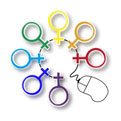
|
The Canadian Association for the Repeal of the Abortion Law is founded. In 1980, it changes its name to the Canadian Abortion Rights Action League (CARAL).
|

|
The Réseau d'action et d'information pour les femmes (RAIF) is founded.
|

|
The first National Lesbian Conference is held in Toronto. Lesbians come together to discuss strategies for organizing autonomously as lesbians, or within the women's and gay rights movements. Subsequent conferences are held in Montreal in 1974 and in Ottawa in 1976.
|

|
Ms. magazine is first published.
|

|
A Quebec jury acquits Dr. Henry Morgentaler for the first time on a charge of committing an illegal abortion. He is subsequently acquitted three times by juries in Ontario and Quebec, only to have those acquittals overturned by higher courts. The Supreme Court of Canada eventually finds in Morgentaler's favour, and in January 1988 declares therapeutic abortion committees (TACs) unconstitutional.
|

|
The Supreme Court of Canada rules that Irene Murdoch, an Alberta rancher, is not entitled to a share of the ranch she and her husband built up over 25 years. Women across Canada are outraged. Irene Murdoch is later granted a lump-sum amount.
|

|
The Supreme Court of Canada narrowly rules in the Jeannette Lavell case that the Indian Act does not discriminate against women, despite the fact that Indian women who marry non-status men lose their Indian status while Indian men confer their status on non-status wives. The National Action Committee on the Status of Women organizes a "Day of Mourning for Canada's Bill of Rights" to protest the decision.
|

|
Women in Thunder Bay, Ontario, organize the first Northern Women's Conference. Shortly afterward, they found the Northern Women's Journal as a forum for the exchange of ideas among Northern Ontario women. The exchange continues 20 years later.
|

|
Canada Post issues a commemorative stamp in honour of the 100th anniversary of the birth of suffragist Nellie McClung.
|

|
The OptiMst, a periodical for Yukon women, is published.
|

|
Canadian Rosella Bjornson becomes the first North American woman airline pilot.
|

|
Rape crisis centres open in Vancouver and in Toronto. They are the first such centres in Western and Central Canada.
|

|
The Canadian Congress for Learning Opportunities for Women (CCLOW) is founded. The CCLOW is a national organization that promotes learning opportunities for women.
|

|
Pauline Jewett becomes the president of Simon Fraser University in British Columbia. She is the first woman president of a co-educational university in Canada.
|

|
The first lesbian newsletter in Canada, Long Time Coming, appears in Montreal.
|

|
The Canadian Women's Negro Association organizes the first national Conference of Black Women. After seven years of annual meetings, they found the Congress of Black Women of Canada.
|

|
The Women's Program of the Secretary of State is created. It becomes an important source of funding for women's organizations across the country.
|

|
Air Canada rescinds its policy preventing married women from being flight attendants (then known as stewardesses).
|

|
The Conseil du statut de la femme (CSF) is founded in Quebec. Its mandate is two-fold: to advise the government on matters relating to the status of women, and to keep women abreast of its analysis and policy positions.
|

